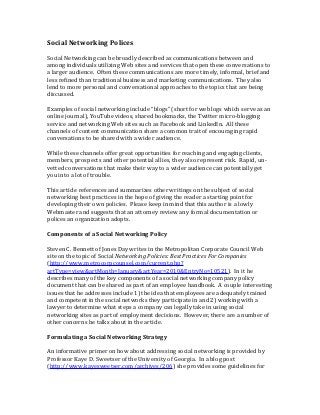
Social networking polices
- 1. Social Networking Polices Social Networking can be broadly described as communications between and among individuals utilizing Web sites and services that open these conversations to a larger audience. Often these communications are more timely, informal, brief and less refined than traditional business and marketing communications. They also lend to more personal and conversational approaches to the topics that are being discussed. Examples of social networking include “blogs” (short for web logs which serve as an online journal), YouTube videos, shared bookmarks, the Twitter micro-blogging service and networking Web sites such as Facebook and LinkedIn. All these channels of content communication share a common trait of encouraging rapid conversations to be shared with a wider audience. While these channels offer great opportunities for reaching and engaging clients, members, prospects and other potential allies, they also represent risk. Rapid, un- vetted conversations that make their way to a wider audience can potentially get you into a lot of trouble. This article references and summarizes other writings on the subject of social networking best practices in the hope of giving the reader a starting point for developing their own policies. Please keep in mind that this author is a lowly Webmaster and suggests that an attorney review any formal documentation or polices an organization adopts. Components of a Social Networking Policy Steven C. Bennett of Jones Day writes in the Metropolitan Corporate Council Web site on the topic of Social Networking Policies: Best Practices For Companies (http://www.metrocorpcounsel.com/current.php? artType=view&artMonth=January&artYear=2010&EntryNo=10521). In it he describes many of the key components of a social networking company policy document that can be shared as part of an employee handbook. A couple interesting issues that he addresses include 1) the idea that employees are adequately trained and competent in the social networks they participate in and 2) working with a lawyer to determine what steps a company can legally take in using social networking sites as part of employment decisions. However, there are a number of other concerns he talks about in the article. Formulating a Social Networking Strategy An informative primer on how about addressing social networking is provided by Professor Kaye D. Sweetser of the University of Georgia. In a blog post (http://www.kayesweetser.com/archives/206) she provides some guidelines for
- 2. entering into social networking. She recommends addressing social networking in three steps; 1) monitoring social networks to see what is being said about a company, 2) engaging individuals through social networks and 3) hosting one’s own space on a social network, such as having a Facebook page. Overall, the article encourages an approach to social networks where the participants first and foremost understand the context and culture of the social network and make sure that this culture fits with that of the company. Dr Sweetser also recommends not using social networks as simply a venue to rebroadcast press releases, but rather focus on content that engages the audience in that network. Hosting Social Networking and Privacy A final component of social networking best practices includes the issue of privacy, particularly the privacy of individuals participating in a social network that is hosted by the company, such as a bulletin board or even comments that may be posted on a blog. Companies should state in their privacy policies how content contributed by their users or visitors can be used by the site, along with how any personal information gathered for purpose of engagement can be used in other activities. A testimonial, for example. Some software may come with its own privacy policy template, such as phpBB (http://www.phpbb.com/community/ucp.php?mode=privacy). Conclusion This article only touches on some of the issues to consider when engaging social networking, but is a good starting point for planning policies and strategies. A key theme that comes across when researching social networking is to address it as a formal communications channel. In other words, treat social networks the same way you would treat a press release, making sure that it meets the same standards for quality and doesn’t include information that shouldn’t be released. If hosting your own social network, make sure that your privacy policy addresses visitor’s participation and how you can use the information they contribute.
